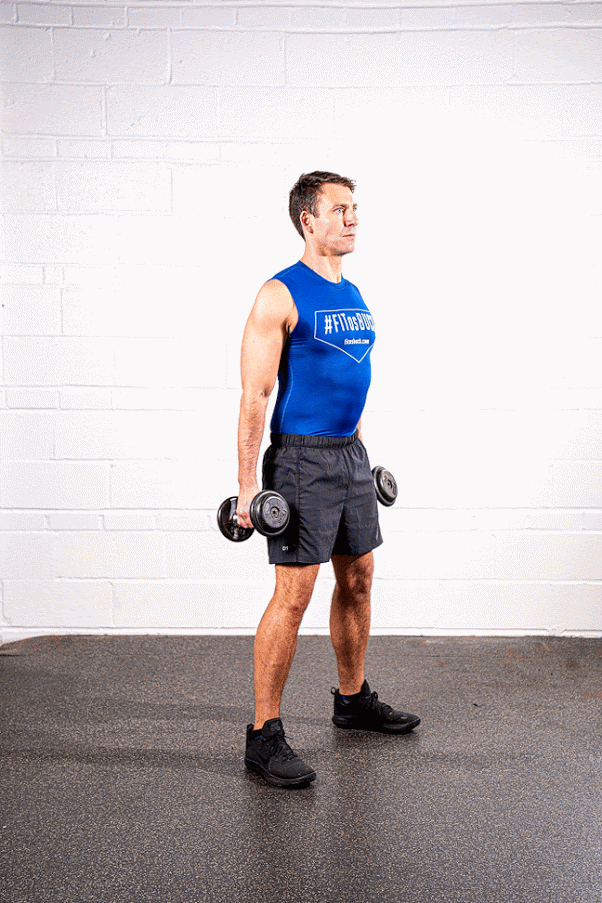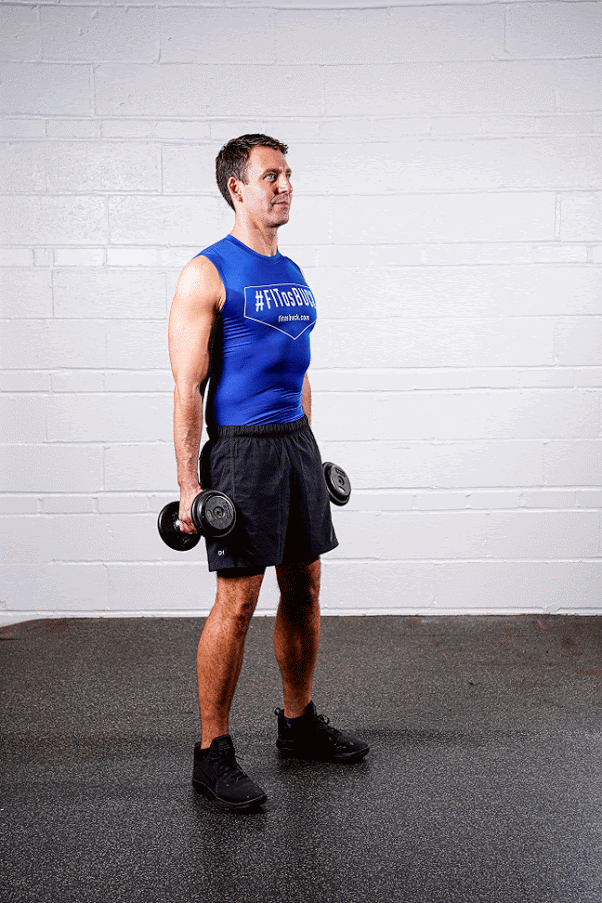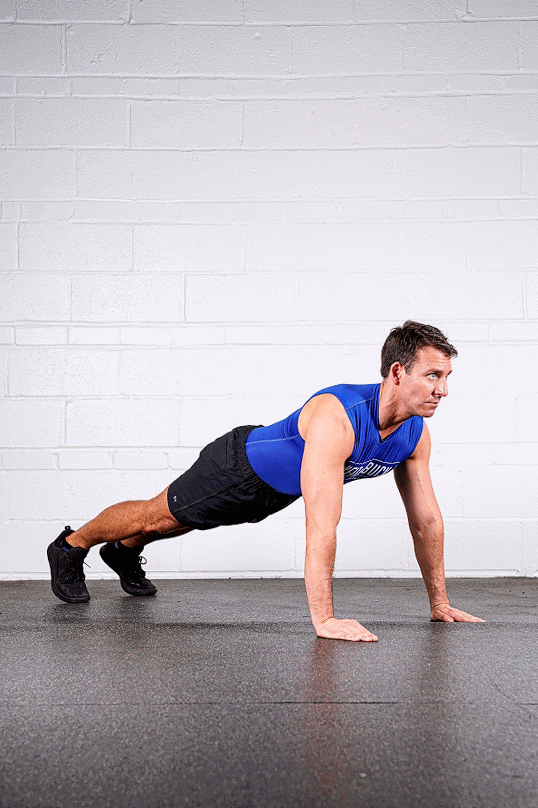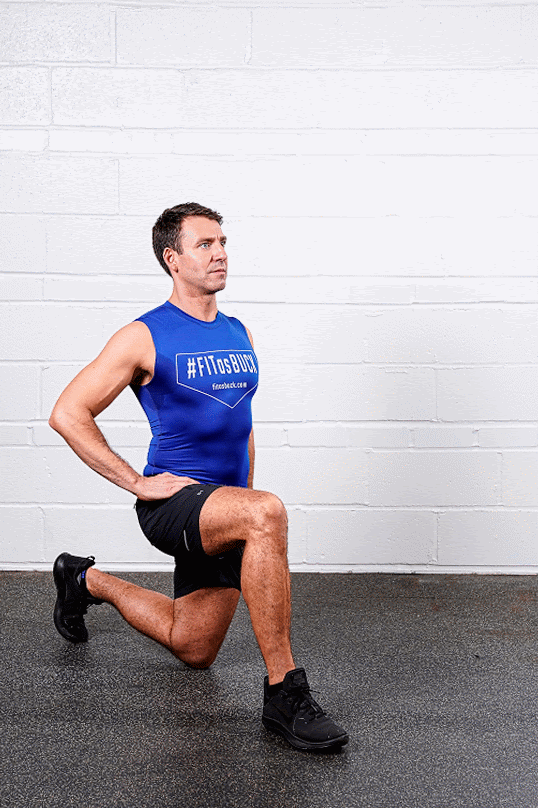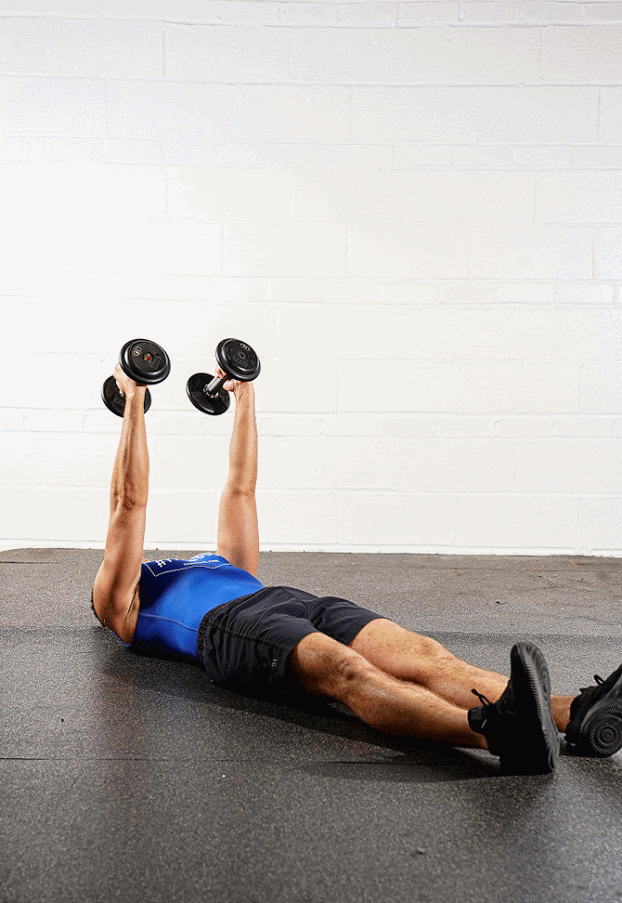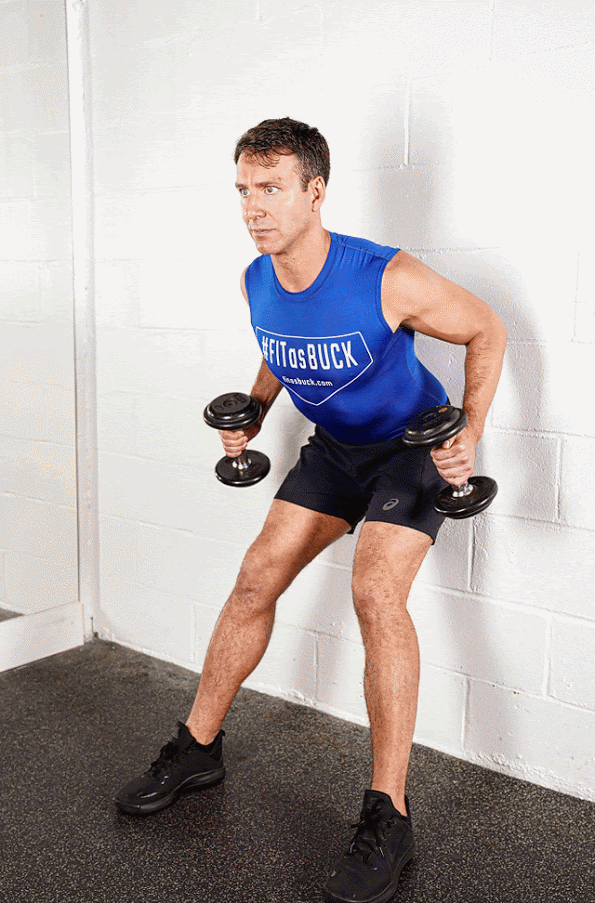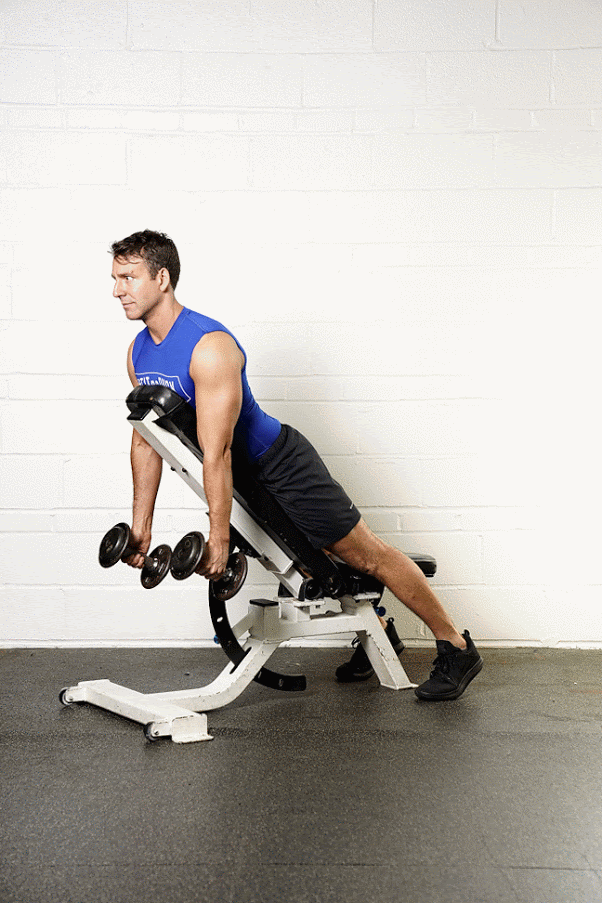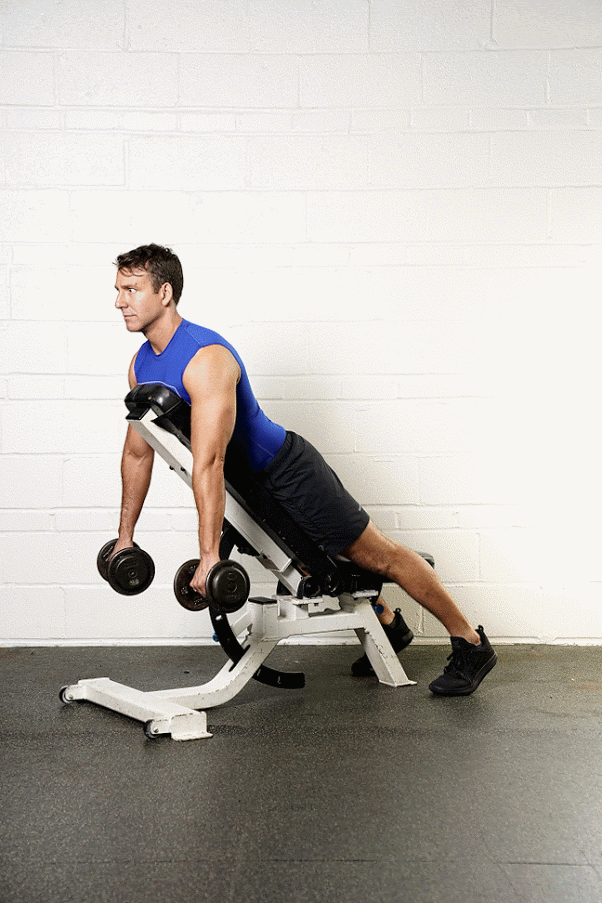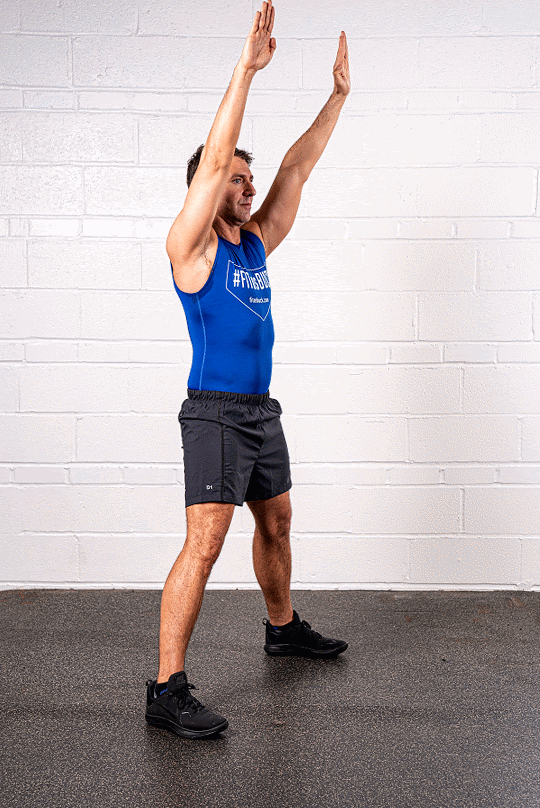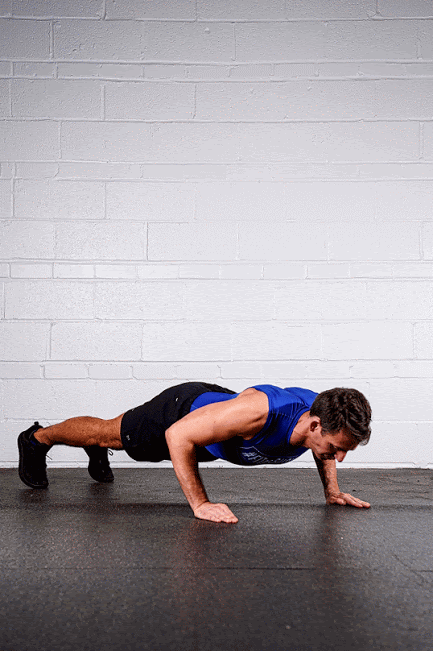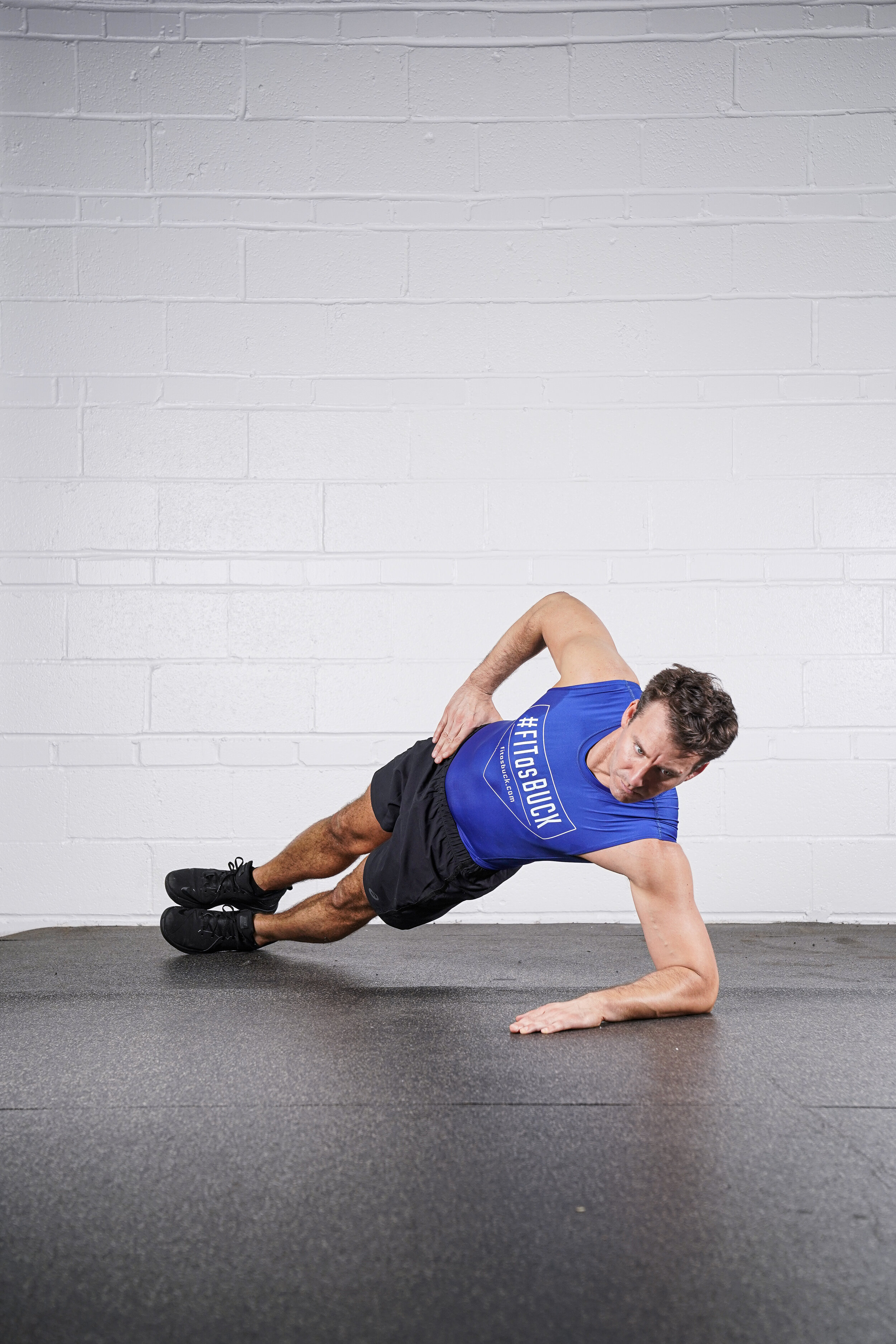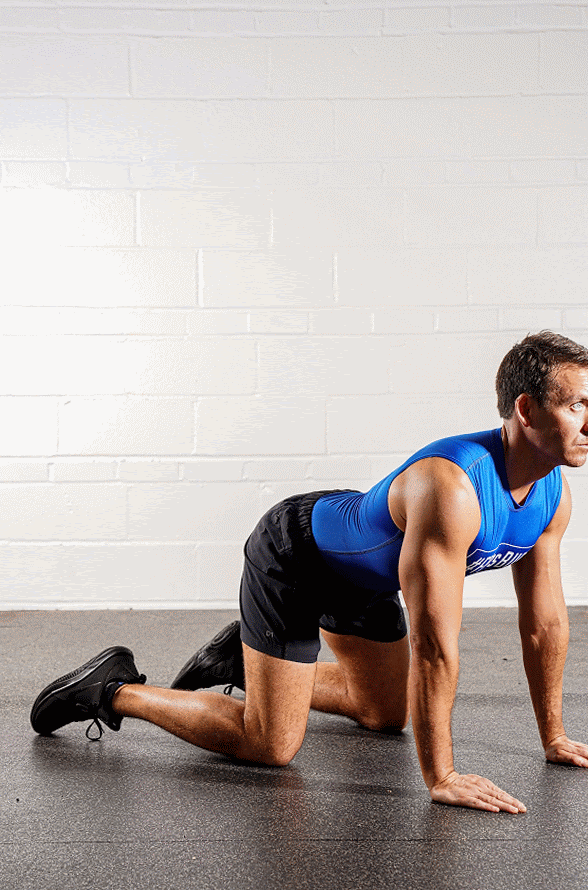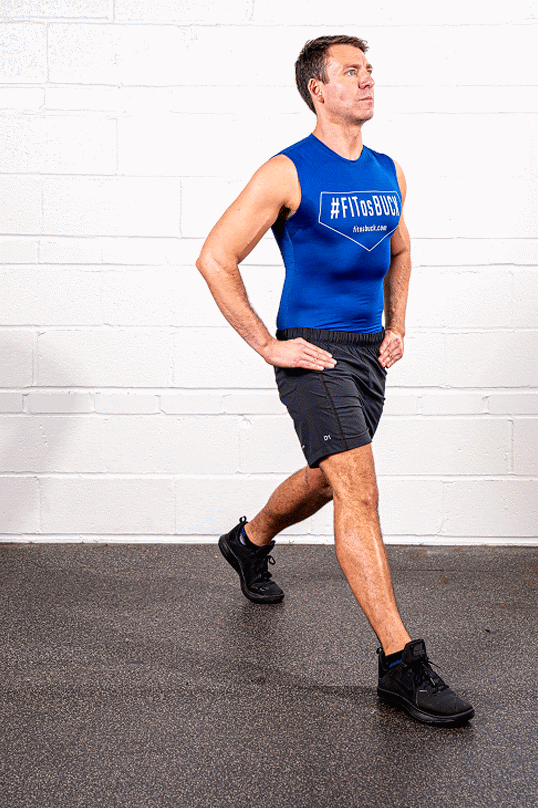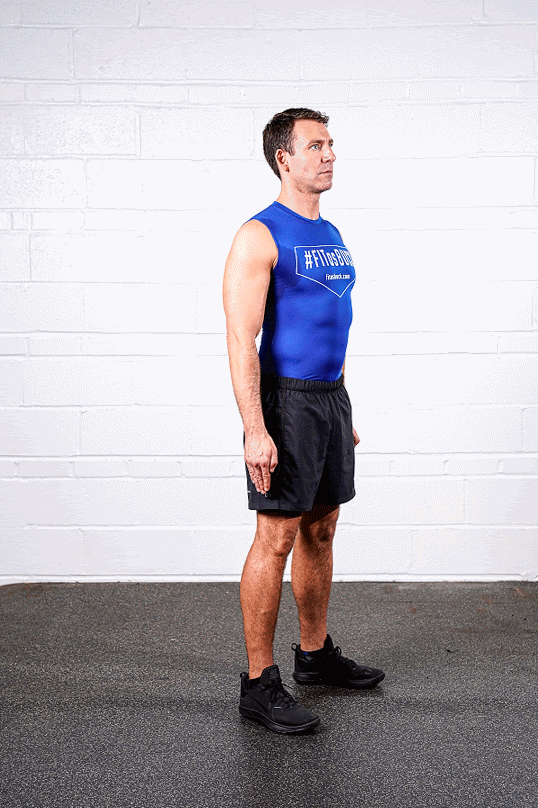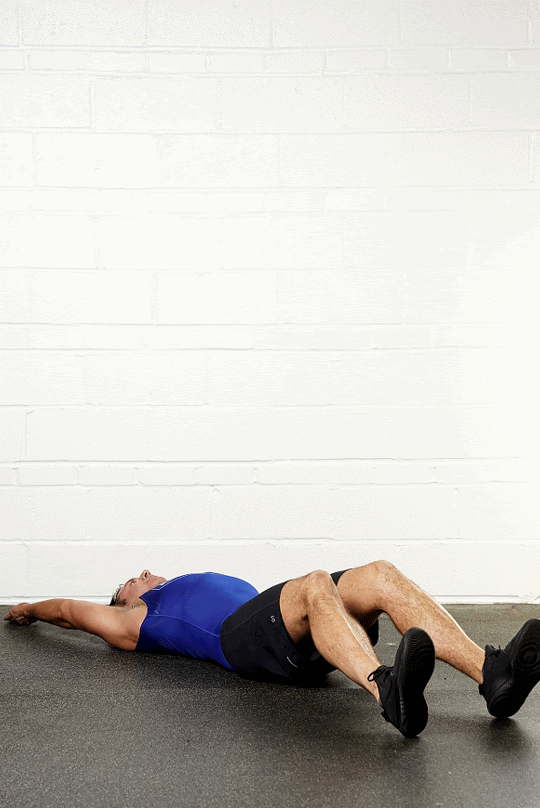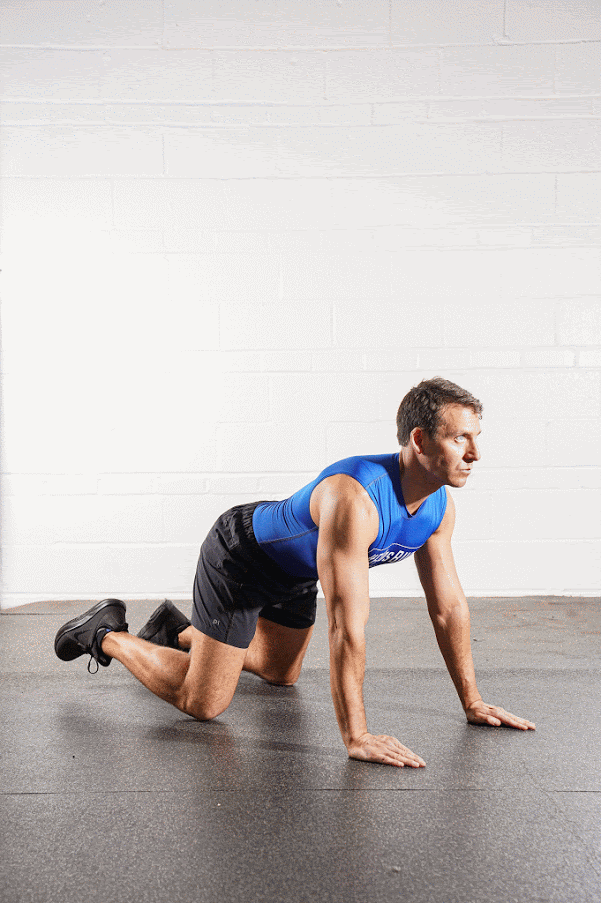FIT AS BUCK >> THE BUCK UP PROGRAM >> BUCK UP INDEX >> LIBRARY OF EXERCISES
library of exercises
Against the Wall – Deadlift
- Starting position wide stance-- knees and toes facing forward. (A little bit of turn out is okay if need be.) Shoulder blades firmly against the wall. Tuck your butt under your spinal column so the small of your back rests against the wall. You will return to this position at the end of each rep.
- Bend at the waist, your chest moving toward the ground. Upper body positioning: flat back, (no rounding of the shoulders), the torso should remain at maximum length as it moves forward (tight abs, no curving of the lower back).
- Go as far down as you can while maintaining that upper body position, pause. You should feel your hamstrings, glutes.
Against the Wall - Neutral Grip Bent Over Row
- Lean forward so torso is completely elongated; flat back, tight core.
- Keep the dumbbells low. Parallel with rib cage, don't let your shoulders ride up as you pull.
- Palms are facing in toward your body
Against the Wall - Overhand Bent Over Row
- Lean forward so torso is completely elongated; flat back, tight core.
- Keep the dumbbells low. Parallel with rib cage, don't let your shoulders ride up as you pull.
- Palms are facing down
Against the Wall - Underhand Bent Over Row
- Lean forward so torso is completely elongated; flat back, tight core.
- Keep the dumbbells low. Parallel with rib cage, don't let your shoulders ride up as you pull.
- Palms facing up.
Angled Front Raise with Chest Against Incline Bench
- Don’t raise your arms too high. Your palms shouldn’t be higher than your chest.
- Keep your upper traps down; don’t let them shrug up toward your ears.
Angled Lawnmower Rows - Left Side
- You don’t need to use a bench. You can use anything that allows you to keep your chest forward, shoulders in neutral position with maximum engagement of the core
- The DB moves back at an angle. Think from your bellybutton to just outside the rib cage.
- Keep the DB low-- the top of the DB should be parallel with the bottom of your rib cage at the end of the row.
Angled Lawnmower Rows - Right Side
- You don’t need to use a bench. You can use anything that allows you to keep your chest forward, shoulders in neutral position with maximum engagement of the core
- The DB moves back at an angle. Think from your bellybutton to just outside the rib cage.
- Keep the DB low-- the top of the DB should be parallel with the bottom of your rib cage at the end of the row.
Angled Shoulder Flies
- Start with arms resting against the side of ribcage and elbows bent as you hold dumbbells in neutral position.
- From there move arms away from body until palms are parallel to the floor.
- Straighten arms from that position without allowing shoulders to ride up.
Behind the Body Resistance Band Pull Apart
- Arms should be as low to the ground as possible
- Keep wrists straight and squeeze your shoulder blades together
Behind the Body Resistance Band Pull Apart Hold
- Arms should be as low to the ground as possible
- Keep wrists straight and squeeze your shoulder blades together
Behind the Neck Triceps Extension
- Don't let your elbows flare out as you extend your arms.
Bent Over Row - Underhand Grip
- It is extremely important that you keep your core tight during the entire exercise.
- Don’t let your shoulders raise up as you row. The dumbbells should be parallel with the bottom of your rib cage in the “row” position.
Biceps Curl
- Keep your shoulders out of it. The point of your elbow should be parallel with the floor in the curl position.
- Be sure your arms make it all the way down on the way back and pause slightly before going into the next rep.
Biceps Curl - 1 side at a time - Left Side
- Keep your shoulders out of it. The point of your elbow should be parallel with the floor in the curl position.
- Be sure your arms make it all the way down on the way back and pause slightly before going into the next rep.
Biceps Curl - 1 side at a time - Right Side
- Keep your shoulders out of it. The point of your elbow should be parallel with the floor in the curl position.
- Be sure your arms make it all the way down on the way back and pause slightly before going into the next rep.
Biceps Curls Half Way - from the bottom to the middle
- Shoulder stabilization is extra important here. Be sure your shoulders are back, that they don’t shrug up as you curl.
- Don’t let the pelvis swing forward as you curl. Squeeze your glutes while curling to prevent this.
Biceps Curls Half Way - from the middle to the top
- Shoulder stabilization is extra important here. Be sure your shoulders are back, that they don’t shrug up as you curl.
- Don’t let the pelvis swing forward as you curl. Squeeze your glutes while curling to prevent this.
Bilateral Reach
- The entire front of your body should be flat on the floor.
- Lift opposite arm and leg as high as possible off the ground without bending arms or legs. (Don’t worry if you don’t get very far.) Don’t let shoulders shrug up or arms or legs move out to the side.
- You will feel this in your mid-back.
Bilateral Reach Hold - First Side
- The entire front of your body should be flat on the floor.
- Lift opposite arm and leg as high as possible off the ground without bending arms or legs. (Don’t worry if you don’t get very far.) Don’t let shoulders shrug up or arms or legs move out to the side.
- You will feel this in your mid-back.
Bilateral Reach Hold - Other Side Side
- The entire front of your body should be flat on the floor.
- Lift opposite arm and leg as high as possible off the ground without bending arms or legs. (Don’t worry if you don’t get very far.) Don’t let shoulders shrug up or arms or legs move out to the side.
- You will feel this in your mid-back.
Bird Dog
- Be sure the leg in the air is completely straight. People cheat this all the time.
- Your body is going to want to lean to the side toward the knee on the ground. You are going to have to fight that by shifting your weight toward the leg in the air.
- Don’t rush.
Bird Dog Hold - First Side
- Be sure the leg in the air is completely straight. People cheat this all the time.
- Your body is going to want to lean to the side toward the knee on the ground. You are going to have to fight that by shifting your weight toward the leg in the air.
Bird Dog Hold - Other Side
- Be sure the leg in the air is completely straight. People cheat this all the time.
- Your body is going to want to lean to the side toward the knee on the ground. You are going to have to fight that by shifting your weight toward the leg in the air.
Body Weight Squat
- The first thing that happens with the lower body is that your hips move back. As your butt starts moving lower to the ground, your hips need to keep moving behind you. This will prevent your knees from coming over your toes.
- Keep your core engaged to prevent over-arching of the back.
- To stabilize the upper body: squeeze your shoulder blades together so the chest stays at maximum width (think of puffing your chest out like a trash-talking redneck about to get in a bar fight.)
- Final body positioning from the top of your head to the bottom of your butt isn’t a straight line-- it’s diagonal.
Burpees
- Burpees suck and that’s why they are effective.
- Easy landings if possible and keep it moving.
Cat Stretch Hold
- Palms directly under shoulders
- Draw your abs in toward the vertebra and all spine to round
- The crown of your head should be parallel with the floor
Chest Press lying on the floor
- Shoulder blades, glutes and small of the back should be on the floor the entire time.
- Elbows should be angled in toward the body not flared out.
- Be sure to keep the movement slow and controlled as you lower the weight back down to the floor.
Chest Press with Hips Elevated
- Don’t let your lower back sag. Keep your hips high and your glutes and core tight for the entire set.
- Easy landings and controlled movement as your arms move back to the floor.
Cobra Push Ups
- Be sure to keep core engaged through the entire exercise including on the way back
- Chest should end up in front of shoulders
Crucifix Sit Up
- Keep your torso completely elongated; chest up shoulders back as you come up.
- Bend your knees as much as you need to but as little as possible.
Deadlift Sumo Stance
- Starting position sumo stance-- knees and toes facing away from the body-- hips are open. Tuck your butt under your spinal column to avoid overarching the back. You will return to this position at the end of each rep.
- Bend at the waist, your chest moving toward the ground. Upper body positioning: flat back, (no rounding of the shoulders), the torso should remain at maximum length as it moves forward (tight abs, no curving of the lower back).
- Go as far down as you can while maintaining that upper body position, pause slightly and then complete the rep by returning to starting position.
Dynamic Child’s Pose
- Careful not to arch your back when you come forward; squeeze your glutes and tighten your abs.
Flat Bench Press
- Starting position: dumbbells should be positioned parallel with the bottom of your chest or possibly even slightly below the chest (most people place their hands too high when bench pressing). Your elbows and hands s hould be angled below your shoulders as opposed to parallel to them. (Think of pressing from a 45 degree angle as opposed to a 90 degree angle.)
- As your arms start moving up, you will rotate slightly so that the inside of your biceps end up facing each other.
- Slowly return to starting position. (This is actually the most important part of the exercise.)
Forearm Push Ups
- If you cannot push up with both arms at the same time, alternate which arm you lead with on each rep.
- Careful not to let the back sag.
Futon Sit Ups
- Torso should be completely elongated and stable throughout the entire movement. Think of leading with your chest
- Bend your knees as much as needed but as little as possible
Glute Bridge
- Get your hips all the way up— squeeze your glutes— and be sure to get your butt all the way back down to the floor before going onto your next rep.
Glute Bridge Hold
- Be sure to squeeze the glutes. You will likely feel this in your lower and middle back-- that's okay.
Goblet Squat
- First thing that happens with the lower body is that your hips move back. As your butt starts moving lower to the ground, your hips need to keep moving behind you. This will prevent your knees from coming over your toes.
- Keep your core engaged to prevent over-arching of the back.
- To stabilize the upper body: squeeze your shoulder blades together so the chest stays at maximum width (think of puffing your chest out like a trash-talking redneck about to get in a bar fight.) On Goblet Squat, hold the weight close to the body and just underneath your sternum to help maintain this position.
- Final body positioning from the top of your head to the bottom of your butt isn’t a straight line-- it’s diagonal.
Hammer Curl
- Keep your arms close to your body.
- The outside of DB should end up parallel to front of shoulder, the tip of your elbow pointing toward the floor.
Hammer Curl - 1 side at a time - Left Side
- Keep your arms close to your body.
- The outside of DB should end up parallel to front of shoulder, the tip of your elbow pointing toward the floor.
Hammer Curl - 1 side at a time - Right Side
- Keep your arms close to your body.
- The outside of DB should end up parallel to front of shoulder, the tip of your elbow pointing toward the floor.
Hammer Curl w Palm Rotation
- Don’t rotate palm until the dumbbell is parallel with front of shoulder.
Hammer Curl w Palm Rotation - alternating with each rep
- Don’t rotate palm until the dumbbell is parallel with front of shoulder.
Hammer Curls w Palm Rotation - 1 side at a time - Left Side
- Don’t rotate palm until the dumbbell is parallel with front of shoulder.
Hammer Curls w Palm Rotation - 1 side at a time - Right Side
- Don’t rotate palm until the dumbbell is parallel with front of shoulder.
Hawk Dodges - Left Side
- Keep all of these movements separate: the hands go down one at a time, same with the knees.
Hawk Dodges - Right Side
- Keep all of these movements separate: the hands go down one at a time, same with the knees.
Hip Flexor Stretch from Push Up Position
- Soft landings on your feet
- Torso should be completely elongated before you twist
Hip Raises
- While drawing your knees in toward your midsection, entire torso, small of the back and butt should be touching the floor
- Use your lower abdominal muscles to get your butt into the air.
- Slow, controlled descent. Delay the point at which your butt returns to the floor as much as possible. This is the hardest part of the exercise.
I-Hops
- Body should be aligned as arms move overhead.
- Your fist moves toward the ground as you launch yourself off the ground.
Iron Butterfly
- You can use the momentum of your arms and knees moving in to get your torso off the mat
- Chest forward, the body must remain at maximum length with each rep
ISO-Burpees
- Keep each movement separate. Pause briefly in each position before moving on to the next one.
- Try to place your feet down as gently as possible.
ISO-Prone Cobra
1) Facedown, palms facing the floor.
2) Pull your shoulder blades together and hold.
3) From there, lift your sternum off the floor and tuck your chin to your sternum. (Imagine trying to look at your bellybutton.)
4) Hold this position for a 3-count and then release.
ISO-Prone Cobra Hold
1) Facedown, palms facing the floor.
2) Pull your shoulder blades together and hold.
3) From there, lift your sternum off the floor.
4) Hold that position and tuck your chin to your sternum. (Imagine trying to look at your bellybutton.) Hold this position.
5) Remember to breathe.
ISO-V-Burpees
- Keep each movement separate. Pause briefly in each position before moving on to the next one.
- Place your feet down as gently as possible on each movement.
- Keep your legs straight and core tight as you step out to the side.
Jumping Jacks
- Just like gym class
- Make sure your arms and legs get all the way out and back. People cheat this all the time.
Knee-to-stand
- Be sure to keep your shoulders back and your chest up as you move.
- Keep your arms out of this: you have to rely on your core and lower body to get yourself up and down.
Knee-to-stand with Hop
- Be sure to keep your shoulders back and your chest up as you move.
- Keep your arms out of this: you have to rely on your core and lower body to get yourself up and down.
Leg Raises
- Entire back of torso should be touching the floor throughout the entire exercise. Your butt never leaves the ground.
- Keep your legs completely straight and feet pointed.
- Controlled movement as legs return to floor.
Leg Raises Hold
- If you start to feel discomfort in the lower back, lift your legs up a bit higher.
Lunge from the ground w DBs
- Keep your upper body aligned: chest up: shoulders aligned with hips.
-Dumbbell should be parallel with middle of your thigh the entire time. Shoulders should remain in fixed position throughout the lunge.
- Don’t worry about getting all the way down to the ground. Go as far as you can without compromising upper body positioning.
- Avoid knees-over toes by squeezing glutes as you move up and down.
Modified Skull Crushers
- Horrible name for a great exercise.
Mountain Climbers
- Be careful not to hunch your shoulders as your legs move behind you.
- Don’t overthink this one. Your feet are basically switching places.
Neutral Grip Bent Over Row
- Lean forward so torso is completely elongated; flat back, tight core.
- Keep the dumbbells low. Parallel with rib cage, don't let your shoulders ride up as you pull.
- Palms are facing in toward your body
Neutral Grip Row with Chest Against Incline Bench
- Think of it almost as if you are doing a plank on an angle. Your body should be at its full length and core still needs to be completely engaged.
- Don’t let gravity pull your shoulders in on the way back down from the row.
One-Legged Glute Bridge
- Be sure to squeeze the glutes. You will likely feel this in your lower and middle back-- that's okay.
- Get all the way back to starting position before going into next rep.
Overhand Row with Chest Against Incline Bench
- Think of it almost as if you are doing a plank on an angle. Your body should be at its full length and core still needs to be completely engaged.
- Don’t let gravity pull your shoulders in on the way back down from the row.
Overhead Squat
- The first thing that happens with the lower body is that your hips move back. As your butt starts moving lower to the ground, your hips need to keep moving behind you. This will prevent your knees from coming over your toes.
- As the hips move back, the challenge will be to keep your chest and arms from falling forward. Pull your shoulder blades together and keep your chest up to prevent this.
- Keep your core engaged to prevent over-arching of the back.
Palm-to-forearm Moving Plank
- Keep core tight the whole time, watch out for over-arching back and rounding shoulders.
Palm-to-toe-sit-ups
- Torso should remain elongated during sit up. You are bending at the waist to touch the palm to toe.
- Bend your knees as much as you need to but as little as possible.
Plank Hold
- Watch out for sagging back and rounding shoulders. Remember to breathe.
Plank into Side Plank - Left Side
- Keep hips and shoulders on side that is not planking aligned as you open up into the plank.
- Reset into push up position after each side plank, take a 1-count hold before opening up into side plank on other side.
Plank into Side Plank - Right Side
- Keep hips and shoulders on side that is not planking aligned as you open up into the plank.
- Reset into push up position after each side plank, take a 1-count hold before opening up into side plank on other side.
Plank Jacks
- Don’t forget the plank part of Plank Jacks. Core needs to remain engaged throughout the entire exercise
Plank Row
- Extremely important that you bring the weights down gently to the ground after the row.
- Must maintain plank position while you row: flat back, tight abs. Watch out for rounding of shoulders and sagging back. Avoid shifting weight to the side with foot on the ground.
Plank with Foot Raise
- Must maintain plank position while the foot comes up: flat back, tight abs. Watch out for rounding of shoulders and sagging back. Avoid shifting weight to the side with foot on the ground.
- Pointed foot and straight leg as your raise your foot.
- Put foot back down gently.
Plank with Shoulder Taps
- Shoulders and hips aligned on the side that is stabilizing (not tapping.)
Push Ups
- Your weight back toward your heels to keep lower body stable.
- If you can’t touch your chest to the floor, don’t. If you can push back up from just past halfway down, you’re going far enough to get
- Your elbows should be angled slightly toward your body, not flared out away from the body. Position palms parallel to arm pits (as opposed to directly parallel with shoulders.)
Reach and Back Jumping Jack
- Keep core tight as your hips move back and your arms reach forward.
- The “Reach and Back” portion of the exercise should be slow and controlled. The jumping jack is fast.
Reaching Squat Jump
- Get your hips all the way back as you reach forward with your arms.
- Use the momentum of your arms moving back and moving your hips to get yourself off the ground.
Resistance Band Neutral Grip Pull Apart
- Keep wrists straight and squeeze your shoulder blades together
Resistance Band Neutral Grip Pull Apart Hold
- Keep wrists straight and squeeze your shoulder blades together
Resistance Band Overhand Overhead Pull Aparts
- Squeeze shoulder blades together as you pull apart.
- Keep your wrists straight.
- Keep your core engaged. Don’t let your pelvis come forward.
Resistance Band Underhand Pull Aparts
- Squeeze shoulder blades together as you pull apart.
- Keep your wrists straight.
- Keep your core engaged. Don’t let your pelvis come forward.
Reverse Lunge
- Take a step back.
- Before you bend your knee, make sure your feet are fully planted and your torso is fully elongated.
- Tuck your butt under your torso to avoid knee rolling over toes.
Shoulder Press Neutral Grip
- The dumbells should be lined up in front of the shoulders.
- Avoid letting your pelvis come forward as you press up.
Side Leg Raises with Resistance Band - Left Side
- Your body should be in a straight line as you lie on your side.
- Keep your legs straight as you raise them.
Side Leg Raises with Resistance Band - Right Side
- Your body should be in a straight line as you lie on your side.
- Keep your legs straight as you raise them.
Side Lunge to Balance - Left Side
- Keep core engaged as you take a wide step out.
- Make sure your feet are fully planted. On the side that you just stepped out on, move your hip back and allow knee to bend. Keep other leg straight.
-To balance: Pick a focal point, make sure your chest is up, and keep your weight on the heel of the foot on the ground. Get the leg off the ground as far in front of you/ as high off the ground as possible. Pause in balance position before going into next rep.
Side Lunge to Balance - Right Side
- Keep core engaged as you take a wide step out.
- Make sure your feet are fully planted. On the side that you just stepped out on, move your hip back and allow knee to bend. Keep other leg straight.
-To balance: Pick a focal point, make sure your chest is up, and keep your weight on the heel of the foot on the ground. Get the leg off the ground as far in front of you/ as high off the ground as possible. Pause in balance position before going into next rep.
Side Plank - Left Side
- When you are in side plank, you can push down with palm to engage your shoulders. Palm and elbow align horizontally, elbow and armpit align vertically.
- Shoulder-to-shoulder should be flat across. Make sure non-planking shoulder stays back.
Side Plank - Right Side
- When you are in side plank, you can push down with palm to engage your shoulders. Palm and elbow align horizontally, elbow and armpit align vertically.
- Shoulder-to-shoulder should be flat across. Make sure non-planking shoulder stays back.
Side Plank Hold - Left Side
- When you are in side plank, you can push down with palm to engage your shoulders. Palm and elbow align horizontally, elbow and armpit align vertically.
- Shoulder-to-shoulder should be flat across. Make sure non-planking shoulder stays back.
Side Plank Hold - Right Side
- When you are in side plank, you can push down with palm to engage your shoulders. Palm and elbow align horizontally, elbow and armpit align vertically.
- Shoulder-to-shoulder should be flat across. Make sure non-planking shoulder stays back.
Sit Back
- Sit Up straight with legs out in front of you, as much bend in the knees as is necessary.
- With your arms straight out in front of you and relaxed shoulders, lean back as far as you can without rounding shoulders or curving spine. Pause.
Sit Back Hold
- Sit Up straight with legs out in front of you, as much bend in the knees as is necessary.
- With your arms straight out in front of you and relaxed shoulders, lean back as far as you can without rounding shoulders or curving spine.
Step Out from All Fours
- After (gently) placing foot outside elbow, pull your upper body forward so your entire torso is elongated.
Step to Lunge
- Stand up straight and keep your core engaged as you take a step forward.
- Before you bend your knee, make sure your feet are fully planted and your torso is fully elongated.
- Tuck your butt under your torso to avoid knee rolling over toes.
Step to Side Lunge - Left Side
- Keep core engaged as you take a wide step out.
- Make sure your feet are fully planted. On the side that you just stepped out on, move your hip back and allow knee to bend. Keep other leg straight.
Step to Side Lunge - Right Side
- Keep core engaged as you take a wide step out.
- Make sure your feet are fully planted. On the side that you just stepped out on, move your hip back and allow knee to bend. Keep other leg straight.
Stiff Legged Deadlift
- Keep the weights close to the front of your legs.
- Think of this as a "back and forth exercise" as opposed to an "up and down" exercise.
- As little bend in the knees as possible. Bend them when you absolutely need to in order to allow your hips to move back.
- Don’t worry about gefftting all the way down. Go as far as you can go while keeping your back flat before coming back up.
Straight Arm Sit Up
- Keep your torso completely elongated; chest up shoulders back as you come up.
- Bend your knees as much as you need to but as little as possible.
Suitcase Deadlift
- This is more of a “back and forth” exercise than an “up and down” exercise. Your knees bend so the hips can move back- not to bring the weights closer to the ground
- Hips move back as the torso moves forward
- Keep belly button drawn in (tight abs) and back flat
- If you can’t make it all the way down to the ground without rounding shoulders, don’t. Go as far as you can and then come back up
Sumo Goblet Squat
- Before you start, open your hips so your feet end up in a turned out position.
- First thing that happens with the lower body is that your hips move back. As your butt starts moving lower to the ground, your hips need to keep moving behind you. This will prevent your knees from coming over your toes.
- Keep your core engaged to prevent over-arching of the back.
- To stabilize the upper body: squeeze your shoulder blades together so the chest stays at maximum width (think of puffing your chest out like a trash-talking redneck about to get in a bar fight.) On Goblet Squat, hold the weight close to the body and just underneath your sternum to help maintain this position.
- Final body positioning from the top of your head to the bottom of your butt isn’t a straight line-- it’s diagonal.
Sumo Squat Jump
- Feet turned out from the hips
- Soft landings
Superman
- Straight arms and straight legs.
- Squeeze your glutes in top position.
- Don't crane your neck. Head should be in neutral position.
- Controlled movement on the way back down.
Superman Hold
- Straight arms and straight legs
- Squeeze your glutes in top position
- Don't crane your neck. Head should be in neutral position. Remember to breathe.
Superman with Pull
- Straight arms, straight legs, tight glutes.
- As you hold Superman position, bend elbows and pull your arms down toward the bottom of your rib cage. Pause briefly before straightening arms again.
- Control the landings as your body returns to floor.
Toe Taps
- Must maintain plank position while the foot steps out to the side and back: flat back, tight abs. Watch out for rounding of shoulders and sagging back. Avoid shifting weight to the side with foot on the ground.
- Keep legs straight, no bending of the knee.
- Soft taps as you step out, light landings when you bring the foot back.
Toes-to-sky Hop
- Reach for the floor as hips move back without rounding shoulders or curving spine.
- Swing up at the waist creating momentum with your hips to bring your body back to standing position.
- Soft landings as you come back down from the hop.
Triceps Dip
- You might look at this gif and think my hands are in a weird position. This is intentional. Palms are facing out (fingertips facing away from the rest of my body.) This will keep your shoulders from internally rotating as you dip.
- Hands are right outside the thighs
- Keep your core tight and chest forward as you move up and down
- Keep your hips back, watch out for the pelvis swinging forward. Your tailbone should practically be brushing up against the bench.
T-Superman
- Arms remain straight out to the side the entire time, legs straight behind you and squeeze glutes as your body comes up. Careful not to let shoulders elevate as your body comes up off the mat.
- Squeeze your shoulder blades together as arms move back behind you in the up position.
- As you hold Superman position, bend elbows and pull your arms down toward the bottom of your rib cage. Pause briefly before straightening arms again.
- Control the landings as your body returns to floor.
T-Superman Hold
- Arms remain straight out to the side the entire time, legs straight behind you and squeeze glutes as your body comes up. Careful not to let shoulders elevate as your body comes up off the mat.
- Squeeze your shoulder blades together as arms move back behind you in the up position.
- As you hold Superman position, bend elbows and pull your arms down toward the bottom of your rib cage. Pause briefly before straightening arms again.
Underhand Chest Press
- Dumbbells should be positioned parallel with the bottom of your chest or possibly even slightly below the chest (most people place their hands too high when bench pressing). Your elbows and hands should be angled below your shoulders as opposed to parallel to them. (Think of pressing from a 45 degree angle as opposed to a 90 degree angle.) Your palms are facing in the direction of the top of the body.
- Entire back side of the body should be touching the floor including shoulder blades and small of back. So abs should be drawn in and glutes squeezed.
- Arms extend straight up. Be careful not to let Shoulder start rotating as you press.
Underhand Row with Chest Against Incline Bench
- Think of it almost as if you are doing a plank on an angle. Your body should be at its full length and core still needs to be completely engaged.
- Don’t let gravity pull your shoulders in on the way back down from the row.
Up and Over Sit Ups
- You can use the momentum of your arms coming up and over to help get off the ground providing you don't round shoulders or curve back.
- You should end up in a seated position with your palms at your side. Your torso should be at maximum length.
Upside Down Turtle
- The entire back side of your body should be touching the floor
- Bend your knees and bring them in toward your midsection.
- Hug outside of shins and pull in toward body.
- Lift your head and tuck your chin to your sternum. Pause. (Remember to breathe.)
V-Burpees
- Easy landings. Try to land without making a sound
- Get your legs out as far as possible for the “V” part of the Burpee
Vertical Leg Extension
- This is more of a core (specifically lower/middle back strengthening) exercise than a lower body exercise so the most important part is keeping the leg straight and get it as far back behind you as possible.
- Don’t have to keep elbows locked. They can bend but only to facilitate the movement of your hips.
- Keep your weight shifted toward the knee on the ground while the opposite leg moves in and out.
W Superman
- Keep head in neutral position.
- Thighs stay down when your upper body is up.
- Squeeze the glutes as you are up in the air. It will take pressure off the small of your back/ belt line.
W Superman Hold
- Keep head in neutral position.
- Thighs stay down when your upper body is up.
- Squeeze the glutes as you are up in the air. It will take pressure off the small of your back/ belt line.
Walkouts
- Start from standing position with knees and toes facing forward.
- Be sure to get all the way out to a push up position. Pause slightly there. Your core should be completely engaged.
- Be sure to return to a full stand before going into the next rep.
Wall Squat
- Keep blades pressed back against wall.
- Small of your back should be pressed against the wall. Tuck your butt under your torso to make that happen.
